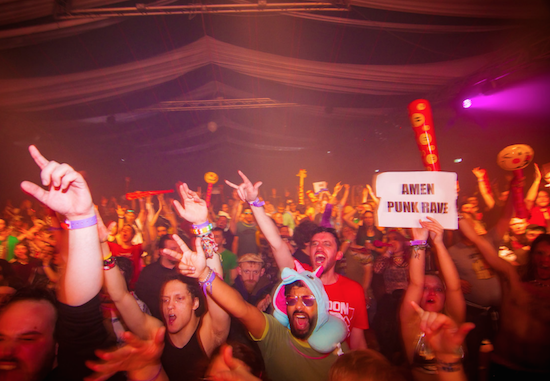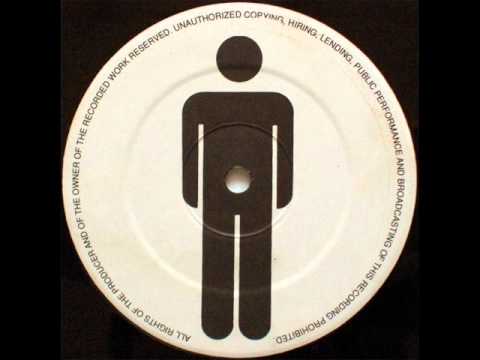One of the constant sources of pain to older ravers – alongside ground-out ankles and the nagging doubt we should have done something significantly better with our lives – is that the music that felt so extreme in our youth ends up sounding rather tame. House music that seemed to race along with the trot of a thoroughbred pony in the ’90s now saunters like a clapped-out Blackpool donkey. Vintage hardcore tracks that once felt like being stamped in the head by industrial pressers now feel expressly tailored to the faster end of our isolation work out.
It’s hard to avoid this kind of feeling when listening to The Most Famous Unknown, a compilation of greatest hits and remixes released in spring 2020 by Marc Acardipane, AKA the Godfather of Hardcore, who has found a new audience thanks to the ongoing gabber / hardcore / hardstyle revival. It’s not that the music here sounds tame exactly; it’s just a hell of a lot less extreme than we once remembered it, wavering around the 150 BPM mark, when extratone has taken us into the wayward lane of 1,000+.
As such, the album poses a conundrum, one that I have been pondering all the more in a year that has been largely bereft of clubs and live music: what does "hard" even mean, when music that once sounded as diabolically durable as Satan’s home fire, can become take-home-to-meet-your-mum presentable 20 years later? Is "hard" a passing garment that music can throw on at will? Or is there something genuinely and eternally tough about certain types of music that will never die or deteriorate?
These might seem like unimportant questions. But given the obsession among musicians about being harder, stronger, faster and more diabolical than all contenders, these are questions that are worth asking. Who, after all, wants to stake their career on being the hardest kid in the musical infants, only to discover two decades later that their productions sound as tame as a church cat? Think it won’t happen to you? Go and listen to Sperminator’s ‘No Woman Allowed’, a record that in 1992 sounded like the hardest, most genuinely shocking thing possible, and tell me that it doesn’t sound a touch restrained in 2020.
So what does "hard" mean, anyway? In a musical sense, "hard" implies loud, fast and distorted, often a combination of all three. Gabber is considered harder than techno because it is faster, despite using many of the same sounds and techniques; in the drum & bass world, Bad Company were considered harder than Goldie because their music is louder and more distorted, despite rattling along at around the same speed. And so on.
Back when people relied on analogue instruments to make their music, there was a skill in playing the fastest. Metal guitarists could be proud of shredding away at indescribable BPMs, knowing that their highly trained fingers were achieving speeds that few people could equal with any kind of precision. But in the electronic music age, where playing fast means little more than clicking a button on a DAW or drum machine and adjusting the velocity, this distinction has gone. Want to play at 335 BPM? Just click here, sir.
Of course, musicians who play ridiculously fast live still require considerable skill to do so – watching Slayer’s drummer in action in 2017 was one of the most incredible musical sights of my life. But this have been devalued by the work of the drum machine, which can take music to levels of velocity that no human could ever imagine. Moby’s ‘Thousand’, for example, claimed the Guinness World Record for the fastest song in 1993 thanks to its 1,000 BPM pace, a speed even Slayer’s Dave Lombardo might consider a little bit excessive. But what does that really mean? Is Moby harder than Slayer just because he goes faster? Is this a route we really want to go down?
The other problem with musical velocity in the electronic world is that there is already nowhere else to go. Extratone – which Bandcamp described as "The World’s Fastest Music Genre" in an eye-opening 2018 feature – typically operates at 1,000 BPM, sometimes going as high as a frankly ludicrous 10,000 BPM. "Extratone is basically a form of extreme sound art," a London-based artist who has identified himself as Rick explains in the Bandcamp feature. "It’s not about pounding kicks but kicks so fast they have morphed into a tonal beast." This is the fascinating – and perhaps frustrating – thing about the genre. You can’t go any faster than extratone. But when extratone artists like Skat Injector do go that fast, the result is almost relaxing, with the bass drum mutating into a weird kind of humming you can almost imagine kicking back to.
You can see this conundrum in action on The Most Famous Unknown. ‘Stereo Murder’ – one of Acardipane’s best known tracks – appears late on in the record, sauntering along at a sedate 141 BPM, the kind of tempo even the most business of techno nights would soon subsume. So what does Perc, on remix duty, do? Does he keep to the original tempo and risk his song sounding a little soft – not the kind of thing a producer with Perc’s reputation for steely techno would take lightly, you feel. Or does he massively speed the track up to keep things satisfactorily hard and modern?
It turns out he does the latter, doubling the original song’s BPM. The results should sound as hard as nails. But at the back of my mind, I can’t help thinking that Perc hasn’t really done anything to beef the track up. There’s no physical work or particular stroke of obtuse genius in simply doubling up the kick drums: all it requires is a rash of dots in his digital audio workstation or a few taps on a button, minor acts of production that Perc could so easily not have done. The line here between fast and slow – and, by extension, hard and soft – feels so porous as to barely exist. Does this hardness by velocity really count? Do those extra dots have any particular reason to be there? Or are they superfluous, like the extra naan bread you always order at the start of a meal before the popadoms arrive to take the edge off your hunger?
A similarly troubling logic applies to volume. Most musicians are incredibly proud of how loud they play. But – as most people who have picked up a guitar or sat at a drum kit can tell you – it is actually a lot harder to play softly. And no one ever boasts about that. Who would buy a record by the world’s quietest guitar player? Who made their fortune by being the world’s most gentle drummer?
Again, the question of technology raises its robotic head: advances in live and recorded music technology mean that records and gigs get ever louder. But does that mean that Leftfield – who apparently reached 137 dB at a Brixton Academy gig in 1996, causing plaster to flake off the ceiling – are harder than, say, The Stooges, who played most of their careers using crappy PAs? Hoary old metallers Manowar held the Guinness record for the loudest band for decades, but has anyone ever thought of Manowar as extreme? And if loudness is something to be appreciated – something that the increasing number of people who wear earplugs to gigs suggest is no longer a given – then who does the credit go to? The amp manufacturers? The roadies who set everything up? The sound tech? These seem unlikely heroes.
A similar argument applies to distortion: true, great amounts of effort and production nous go into making music sound abrasively loud or perfectly distorted. But can you really take the credit for the guitar pedals, amps or digital plugins you use to make your record sound noisier than everyone else, however cleverly you might employ them? And what happens when the next guitar pedal / plug in / effect comes along and makes your slavishly distorted record sound as pure as the driven snow? Drum & bass, once the most thrillingly experimental music in the world, is a particular example of the pitfalls of distortion wars, losing its way in the late 1990s when producers went from experimenting with the wildest drum funk to trying to sound the nastiest and bassiest possible. That this coincided – just about – with the rise of Napster, the MP3 and crappy computer speakers is a particularly rich irony.
Then there’s the question of gender stereotypes. I think we can probably take Sperminator’s ‘No Women Allowed’ as an example of that elusive Dutch humour. Rotterdam Records, which released the song, was also responsible for Rotterdam Termination Source’s legendarily provocative ‘Poing’, after all, and once released an album called Hardcore Cheddar. But the hardcore / gabber scene was historically very male (and very white) to the extent that Bianca Ludewig, a hardcore scholar and member of the female:pressure network, told Mixmag that hardcore has "this huge his-story and no her-story."
Nowadays, hardcore music is a lot more equally represented, thanks to DJs like Lady Dana and Miss Hysteria. But the horrendous myth that hard = male and soft = female persists. In 2017, David Welch and Guy Fremaux from the University of Auckland published a qualitative study into why people like loud sounds, in which they found that loudness "was felt to emphasise a masculine identity and ‘being cool’." "Participants thought that some people may like loud sounds because they associated them with masculinity, and used them to emphasise their masculinity," they wrote.
Obviously, the supposed link between masculinity and noise is one of perception, rather than scientific fact, as Welch and Fremaux acknowledge. "We presume that responses about masculinity related to culturally-accepted norms for the genders, with masculinity being associated with activity and danger versus femininity which tends to be associated with calmness and tranquillity," they note. In fact, they put one of the appeals of loudness down to "the ability to overcome a fear-response, a sense of self-control and power [which] may be pleasurable for both genders". But perception – for all that it might be wrong – is important and it will take a vast deal of effort for this false equivalence to shift. Consider, for example, the example of ‘brostep’, a misbegotten musical genre whose name proves that we still associate "male" with "volume."
Perhaps, then, instead of thinking ‘how hard can I go?’, musicians should take this time out from clubbing and live music to question why they want to go hard. If you’re doing it just to produce something unpleasant, then I can guarantee you will never make anything that annoys me as much as my sleep-deprived six-year-old son shouting for ice cream. And if you’re doing it for mere extremity’s sake, then how will you feel in 20 years’ time when people look back on your record and wonder how something this tame ever felt so hard?
For all that, this is not an argument against being hard: it’s an argument against being hard for hard’s sake and in favour of the judicious use of hardness when working towards a wider goal. Kevin Shields’ obsessive audio tinkering gives My Bloody Valentine live shows a genuinely transcendent feel that is both loud and surreal, the band producing a fascinatingly alien sound that is almost serene in its extremity. Sunn O))), meanwhile, apparently tune their guitars to the frequencies of the buildings where they perform, a cunning act of audio obsession with uniquely moving results.
As for Marc Acardipane, while the music on The Most Famous Unknown rarely sounds as extreme as its creators may have wanted, stepping away from the shock and awe his music once inspired reveals unexpected new strengths, from the twisted melodic urges of ‘Disaster Area”s sick-in-the-mouth riff to the bizarre Teutonic funkiness of ‘Stereo Murder’. That might not be rather unexpected from an album that is home to songs like ‘O.K. Bassquake’, ‘Drunken Piece Of Shit’ and ‘Slaves To The Rave’, but even for the Godfather of Hardcore it seems that there’s more to life than hardness.




